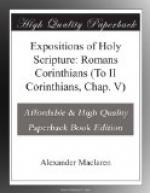But I do not mean here to speak so much about the general bearing of this text as rather to deal with its designation of the aim and reward of Christian energy, that ‘incorruptible crown’ of which my text speaks. And in doing so I desire to take into account likewise other places in Scripture in which the same metaphor occurs.
I. The crown.
Let me recall the other places where the same metaphor is employed. We find the Apostle, in the immediate prospect of death, rising into a calm rapture in which imprisonment and martyrdom lose their terrors, as he thinks of the ‘crown of righteousness’ which the Lord will give to him. The Epistle of James, again, assures the man who endures temptation that ’the Lord will give him the crown of life which He has promised to all them that love Him.’ The Lord Himself from heaven repeats that promise to the persecuted Church at Smyrna: ‘Be thou faithful unto death, and I will give thee a crown of life.’ The elders cast their crowns before the feet of Him that sitteth upon the throne. The Apostle Peter, in his letter, stimulates the elders upon earth to faithful discharge of their duty, by the hope that thereby they shall ’receive a crown of righteousness that fadeth not away.’ So all these instances taken together with this of my text enable us to gather two or three lessons.
It is extremely unlikely that all these instances of the occurrence of the emblem carry with them reference, such as that in my text, to the prize at the athletic festivals. For Peter and James, intense Jews as they were, had probably never seen, and possibly never heard of, the struggles at the Isthmus and at Olympus and elsewhere. The Book of the Revelation draws its metaphors almost exclusively from the circle of Jewish practices and things. So that we have to look in other directions than the arena or the racecourse to explain these other uses of the image. It is also extremely unlikely that in these other passages the reference is to a crown as the emblem of sovereignty, for that idea is expressed, as a rule, by another word in Scripture, which we have Anglicised as ‘diadem.’ The ‘crown’ in all these passages is a garland twisted out of some growth of the field. In ancient usage roses were twined for revellers; pine-shoots or olive branches for the victors in the games; while the laurel was ‘the meed of mighty conquerors’; and plaited oak leaves were laid upon the brows of citizens who had deserved well of their country, and myrtle sprays crowned the fair locks of the bride.
And thus in these directions, and not towards the wrestling ground or the throne of the monarch, must we look for the ideas suggested by the emblem.




